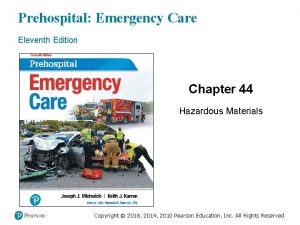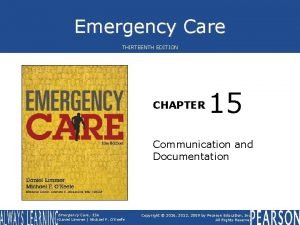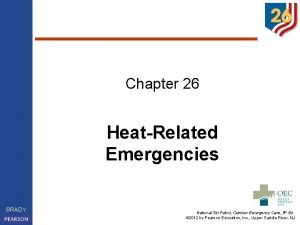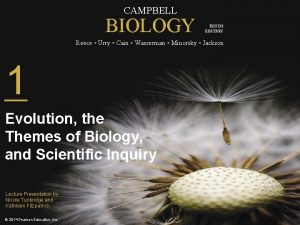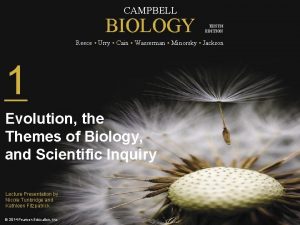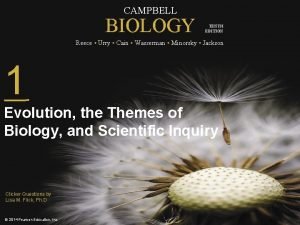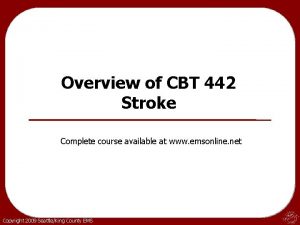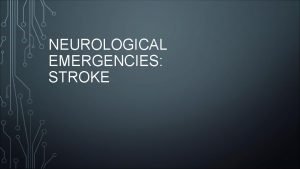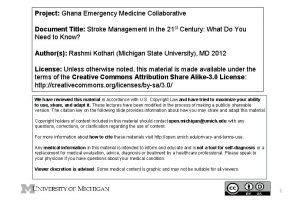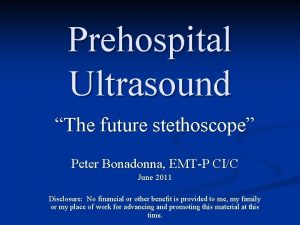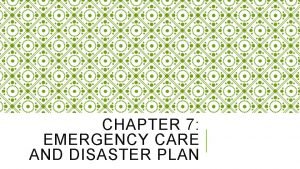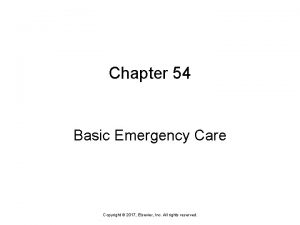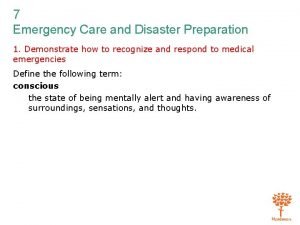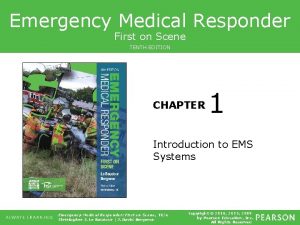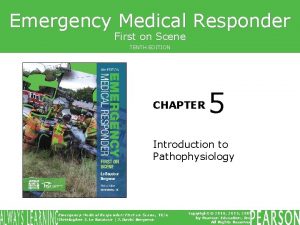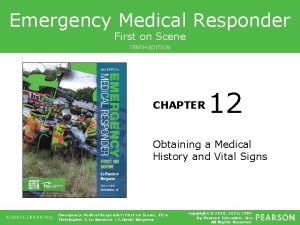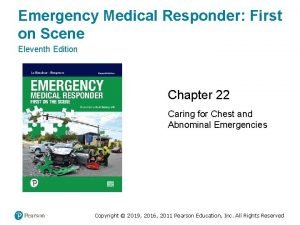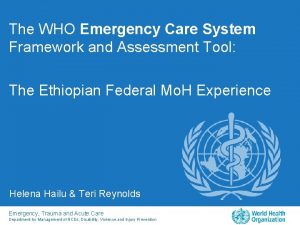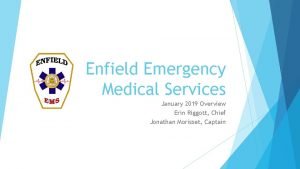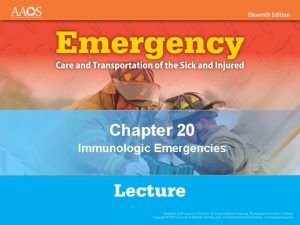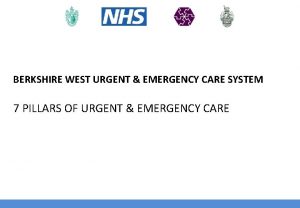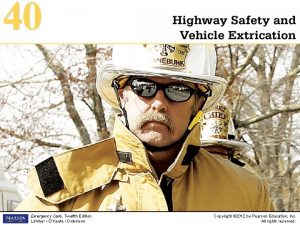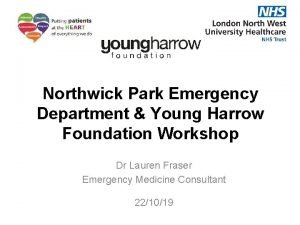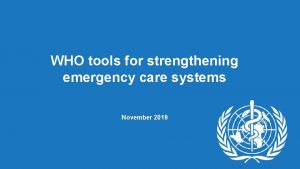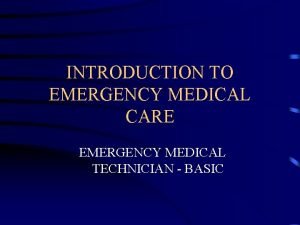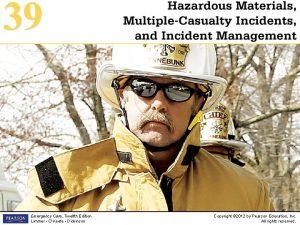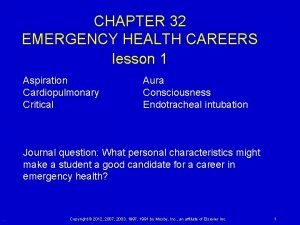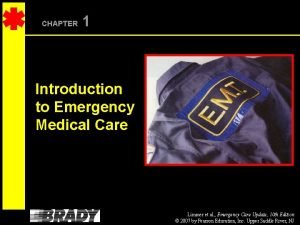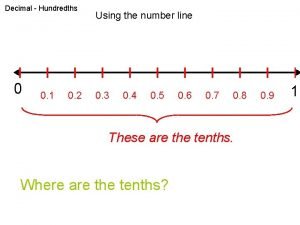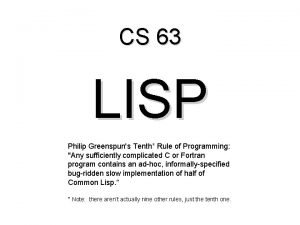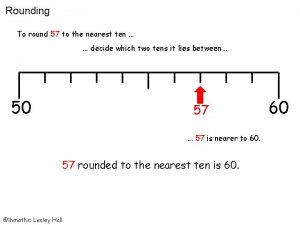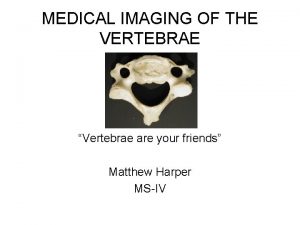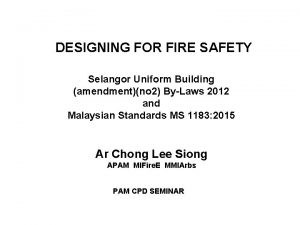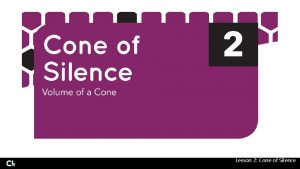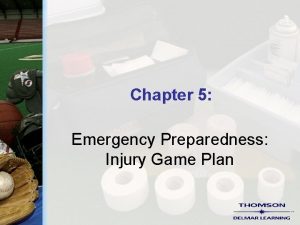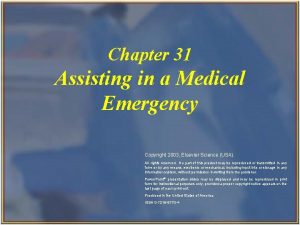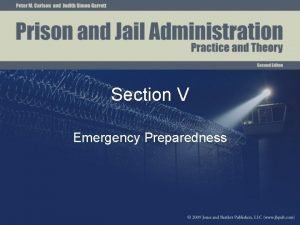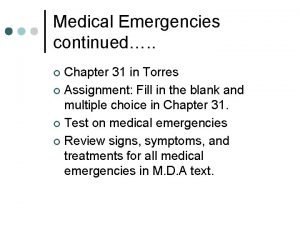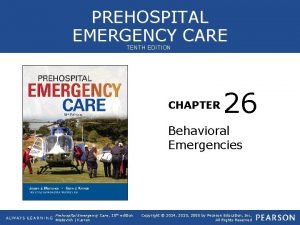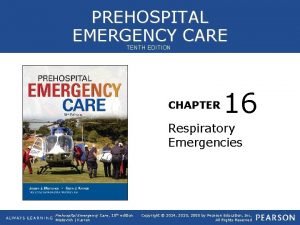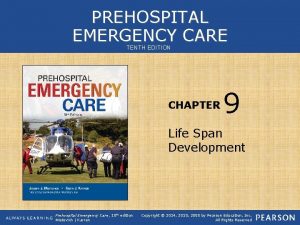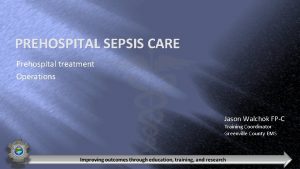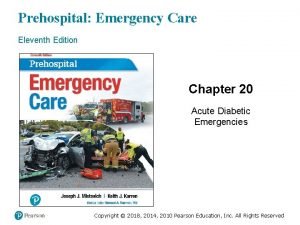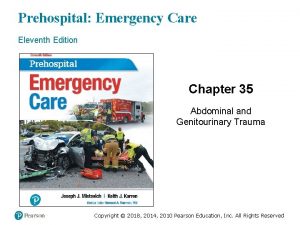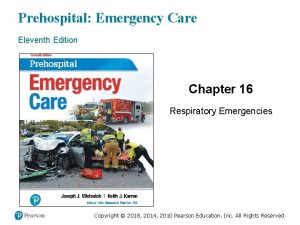PREHOSPITAL EMERGENCY CARE TENTH EDITION CHAPTER 22 Part
















































































- Slides: 80

PREHOSPITAL EMERGENCY CARE TENTH EDITION CHAPTER 22 Part I Toxicologic Emergencies Prehospital Emergency Care, 10 th edition Mistovich | Karren Copyright © 2014, 2010, 2008 by Pearson Education, Inc. All Rights Reserved

Setting the Stage • Overview of Lesson Topics § Poisons and Poisoning § Ingested, Inhaled, Injected, and Absorbed Poisons Prehospital Emergency Care, 10 th edition Mistovich | Karren Copyright © 2014, 2010, 2008 by Pearson Education, Inc. All Rights Reserved

Introduction • Poisoning may be accidental or intentional. • Many calls to poison control centers involve children. • There are special problems associated with drug and alcohol emergencies. Prehospital Emergency Care, 10 th edition Mistovich | Karren Copyright © 2014, 2010, 2008 by Pearson Education, Inc. All Rights Reserved

Poisons and Poisoning • A poison is any substance that impairs health or causes death by its chemical. • Moist poisonings are accidental, and involve young children. • Other causes of poisoning include suicide and homicide. continued on next slide Prehospital Emergency Care, 10 th edition Mistovich | Karren Copyright © 2014, 2010, 2008 by Pearson Education, Inc. All Rights Reserved

Poisons and Poisoning • Toxicology is the study of toxins and antidotes. • Overdose of drugs or medications is a type of poisoning. continued on next slide Prehospital Emergency Care, 10 th edition Mistovich | Karren Copyright © 2014, 2010, 2008 by Pearson Education, Inc. All Rights Reserved

EMT SKILLS 22 -1 Routes of Exposure continued on next slide Prehospital Emergency Care, 10 th edition Mistovich | Karren Copyright © 2014, 2010, 2008 by Pearson Education, Inc. All Rights Reserved

Ingestion. continued on next slide Prehospital Emergency Care, 10 th edition Mistovich | Karren Copyright © 2014, 2010, 2008 by Pearson Education, Inc. All Rights Reserved

Absorption. continued on next slide Prehospital Emergency Care, 10 th edition Mistovich | Karren Copyright © 2014, 2010, 2008 by Pearson Education, Inc. All Rights Reserved

Inhalation. continued on next slide Prehospital Emergency Care, 10 th edition Mistovich | Karren Copyright © 2014, 2010, 2008 by Pearson Education, Inc. All Rights Reserved

Injection. continued on next slide Prehospital Emergency Care, 10 th edition Mistovich | Karren Copyright © 2014, 2010, 2008 by Pearson Education, Inc. All Rights Reserved

Poisons and Poisoning • Signs and symptoms depend on the specific poison and the route of entry into the body. • Always be prepared for patient deterioration in a suspected poisoning. • Monitor the mental status, airway, and breathing. continued on next slide Prehospital Emergency Care, 10 th edition Mistovich | Karren Copyright © 2014, 2010, 2008 by Pearson Education, Inc. All Rights Reserved

Poisons and Poisoning • Most care for poisoning patients is supportive. § Intervene in airway, breathing, oxygenation, and circulation as needed. § Monitor mental status. § Be prepared for vomiting. § Frequent reassessment continued on next slide Prehospital Emergency Care, 10 th edition Mistovich | Karren Copyright © 2014, 2010, 2008 by Pearson Education, Inc. All Rights Reserved

Poisons and Poisoning • Few antidotes are available. • Treatment is geared toward limiting or preventing absorption of the poison, and treating signs and symptoms. Prehospital Emergency Care, 10 th edition Mistovich | Karren Copyright © 2014, 2010, 2008 by Pearson Education, Inc. All Rights Reserved

Ingested Poisons • Commonly ingested substances § § Over-the-counter medications Illegal drugs Household products Cleaning agents continued on next slide Prehospital Emergency Care, 10 th edition Mistovich | Karren Copyright © 2014, 2010, 2008 by Pearson Education, Inc. All Rights Reserved

Ingested Poisons • Commonly ingested substances § § Foods Insecticides Petroleum products Plants continued on next slide Prehospital Emergency Care, 10 th edition Mistovich | Karren Copyright © 2014, 2010, 2008 by Pearson Education, Inc. All Rights Reserved

Ingested Poisons • Factors in ingested poisoning include: § Not understanding directions for medications § Combining alcohol and drugs § Storing poisons in food or drink containers § Poisons within reach of children continued on next slide Prehospital Emergency Care, 10 th edition Mistovich | Karren Copyright © 2014, 2010, 2008 by Pearson Education, Inc. All Rights Reserved

Poisoning is the number one cause of accidental death among children. continued on next slide Prehospital Emergency Care, 10 th edition Mistovich | Karren Copyright © 2014, 2010, 2008 by Pearson Education, Inc. All Rights Reserved

Ingested Poisons • Assessment-based approach § The scene size-up can give valuable clues to the substance involved. continued on next slide Prehospital Emergency Care, 10 th edition Mistovich | Karren Copyright © 2014, 2010, 2008 by Pearson Education, Inc. All Rights Reserved

Ingested Poisons • Assessment-based approach § Primary assessment • Assess mental status. • Assess the airway, anticipate vomiting; intervene as needed. • Provide positive pressure ventilation as needed. • Maintain oxygenation (Sp. O 2 94% or higher). • Assess circulation. continued on next slide Prehospital Emergency Care, 10 th edition Mistovich | Karren Copyright © 2014, 2010, 2008 by Pearson Education, Inc. All Rights Reserved

Ingested Poisons • Assessment-based approach § Secondary assessment • History • Consider that multiple substances may be involved. • Consider the trustworthiness of the history from a patient who has overdosed. continued on next slide Prehospital Emergency Care, 10 th edition Mistovich | Karren Copyright © 2014, 2010, 2008 by Pearson Education, Inc. All Rights Reserved

Ingested Poisons • Ask the following: What substance was ingested? Was alcohol also ingested? When was the substance ingested? Over what time period did the ingestion occur? § How much of the substance was taken? § § continued on next slide Prehospital Emergency Care, 10 th edition Mistovich | Karren Copyright © 2014, 2010, 2008 by Pearson Education, Inc. All Rights Reserved

Ingested Poisons • Ask the following: § Has anyone attempted treatment? § Does the patient have a psychiatric history? § Are there any underlying illnesses? § How much does the patient weigh? § What medications are available at the scene? continued on next slide Prehospital Emergency Care, 10 th edition Mistovich | Karren Copyright © 2014, 2010, 2008 by Pearson Education, Inc. All Rights Reserved

Ingested Poisons • Physical exam § Focus on complaints; if the mental status is altered perform a complete secondary assessment. § Vital signs continued on next slide Prehospital Emergency Care, 10 th edition Mistovich | Karren Copyright © 2014, 2010, 2008 by Pearson Education, Inc. All Rights Reserved

Ingested Poisons • Signs and symptoms § History of ingestion § Swelling of mucous membranes of the mouth § Nausea, vomiting § Diarrhea § Altered mental status continued on next slide Prehospital Emergency Care, 10 th edition Mistovich | Karren Copyright © 2014, 2010, 2008 by Pearson Education, Inc. All Rights Reserved

Discoloration or burns around the mouth are signs of possible poisoning. continued on next slide Prehospital Emergency Care, 10 th edition Mistovich | Karren Copyright © 2014, 2010, 2008 by Pearson Education, Inc. All Rights Reserved

Ingested Poisons • Signs and symptoms § Abdominal pain, tenderness § Burns or stains around the mouth; pain in the mouth or throat § Unusual breath or body odors § Respiratory distress § Altered heart rate continued on next slide Prehospital Emergency Care, 10 th edition Mistovich | Karren Copyright © 2014, 2010, 2008 by Pearson Education, Inc. All Rights Reserved

Ingested Poisons • Signs and symptoms § § § Altered blood pressure Dilated or constricted pupils Warm and dry or cool and moist skin Altered mental status Coma Seizures continued on next slide Prehospital Emergency Care, 10 th edition Mistovich | Karren Copyright © 2014, 2010, 2008 by Pearson Education, Inc. All Rights Reserved

Ingested Poisons • Emergency medical care § Maintain the airway, protect from aspiration. § Assist inadequate ventilations. § Maintain oxygenation. § Prevent further injury. continued on next slide Prehospital Emergency Care, 10 th edition Mistovich | Karren Copyright © 2014, 2010, 2008 by Pearson Education, Inc. All Rights Reserved

Ingested Poisons • Emergency medical care § Consult medical direction or poison control center; activated charcoal may be ordered. § Bring the substance to the hospital. § Reassess frequently. continued on next slide Prehospital Emergency Care, 10 th edition Mistovich | Karren Copyright © 2014, 2010, 2008 by Pearson Education, Inc. All Rights Reserved

Ingested Poisons • Activated charcoal § May occasionally be used with ingestion of certain substances § No evidence that it improves outcomes § Risk of aspiration continued on next slide Prehospital Emergency Care, 10 th edition Mistovich | Karren Copyright © 2014, 2010, 2008 by Pearson Education, Inc. All Rights Reserved

Ingested Poisons • Activated charcoal § Absorbs certain toxins, preventing them from being absorbed into the body § If given, it should be given within one hour of ingestion of the poison. § Must be administered only under medical direction continued on next slide Prehospital Emergency Care, 10 th edition Mistovich | Karren Copyright © 2014, 2010, 2008 by Pearson Education, Inc. All Rights Reserved

Ingested Poisons • Activated charcoal § Never give to a patient with altered mental status or inability to swallow § Do not give in cases of ingestion of acids or alkalis. § Usual dosage • 1 g/kg Prehospital Emergency Care, 10 th edition Mistovich | Karren Copyright © 2014, 2010, 2008 by Pearson Education, Inc. All Rights Reserved

Several brands and forms of activated charcoal are available. Prehospital Emergency Care, 10 th edition Mistovich | Karren Copyright © 2014, 2010, 2008 by Pearson Education, Inc. All Rights Reserved

EMT SKILLS 22 -2 Administering Activated Charcoal Prehospital Emergency Care, 10 th edition Mistovich | Karren Copyright © 2014, 2010, 2008 by Pearson Education, Inc. All Rights Reserved

Obtain an order from medical direction. Prehospital Emergency Care, 10 th edition Mistovich | Karren Copyright © 2014, 2010, 2008 by Pearson Education, Inc. All Rights Reserved

Place the activated charcoal in a cup with a lid. A straw may also help to improve the patient's willingness to drink the charcoal. Prehospital Emergency Care, 10 th edition Mistovich | Karren Copyright © 2014, 2010, 2008 by Pearson Education, Inc. All Rights Reserved

Observe the patient drinking the charcoal. Prehospital Emergency Care, 10 th edition Mistovich | Karren Copyright © 2014, 2010, 2008 by Pearson Education, Inc. All Rights Reserved

Record the dose and time the charcoal was administered. Prehospital Emergency Care, 10 th edition Mistovich | Karren Copyright © 2014, 2010, 2008 by Pearson Education, Inc. All Rights Reserved

Inhaled Poisons • Common inhaled poisons § § Carbon monoxide Carbon dioxide Chlorine gas Fumes from liquid chemicals and sprays continued on next slide Prehospital Emergency Care, 10 th edition Mistovich | Karren Copyright © 2014, 2010, 2008 by Pearson Education, Inc. All Rights Reserved

Inhaled Poisons • Common inhaled poisons § § Ammonia Sulfur dioxide Anesthetic gases Solvents used in dry cleaning, degreasing agents, fire extinguishers continued on next slide Prehospital Emergency Care, 10 th edition Mistovich | Karren Copyright © 2014, 2010, 2008 by Pearson Education, Inc. All Rights Reserved

Inhaled Poisons • Common inhaled poisons § § Industrial gases Incomplete combustion of natural gas Hydrogen sulfide Nitrogen dioxide continued on next slide Prehospital Emergency Care, 10 th edition Mistovich | Karren Copyright © 2014, 2010, 2008 by Pearson Education, Inc. All Rights Reserved

Inhaled Poisons • Intentional inhalation of certain substances, such as propellants, is called huffing. • Huffing can result in displacement of oxygen from the lungs, and can have toxic effects and cause damage to the alveoli. continued on next slide Prehospital Emergency Care, 10 th edition Mistovich | Karren Copyright © 2014, 2010, 2008 by Pearson Education, Inc. All Rights Reserved

Inhaled Poisons • Commonly abused inhalants § § § § Paints Freon Gas propellants Glue Nitrous oxide Amyl nitrate Butyl nitrate continued on next slide Prehospital Emergency Care, 10 th edition Mistovich | Karren Copyright © 2014, 2010, 2008 by Pearson Education, Inc. All Rights Reserved

Inhaled Poisons • Assessment-based approach § Scene size-up • Be aware of your own safety; note odors or fumes. • Some inhaled poisons are colorless and odorless. • Placards continued on next slide Prehospital Emergency Care, 10 th edition Mistovich | Karren Copyright © 2014, 2010, 2008 by Pearson Education, Inc. All Rights Reserved

Inhaled Poisons • Assessment-based approach § Scene size-up • If hazardous materials are involved, request resources. • Do not enter the scene unless it is safe. • Determine the number of patients. continued on next slide Prehospital Emergency Care, 10 th edition Mistovich | Karren Copyright © 2014, 2010, 2008 by Pearson Education, Inc. All Rights Reserved

Protect yourself. Have trained rescuers remove the patient from the toxic environment. continued on next slide Prehospital Emergency Care, 10 th edition Mistovich | Karren Copyright © 2014, 2010, 2008 by Pearson Education, Inc. All Rights Reserved

Inhaled Poisons • Assessment-based approach § Primary assessment Assess and closely monitor the airway. Assess and closely monitor breathing. Assist inadequate breathing. For adequate breathing, apply oxygen by nonrebreather mask. • Assess circulation. • • continued on next slide Prehospital Emergency Care, 10 th edition Mistovich | Karren Copyright © 2014, 2010, 2008 by Pearson Education, Inc. All Rights Reserved

Administer oxygen to the inhaled poisoning patient. continued on next slide Prehospital Emergency Care, 10 th edition Mistovich | Karren Copyright © 2014, 2010, 2008 by Pearson Education, Inc. All Rights Reserved

Inhaled Poisons • Assessment-based approach § Secondary assessment • Consider trauma • History • Physical exam continued on next slide Prehospital Emergency Care, 10 th edition Mistovich | Karren Copyright © 2014, 2010, 2008 by Pearson Education, Inc. All Rights Reserved

Inhaled Poisons • Ask the following: § Does the history suggest a suicide attempt? § Did the exposure occur in an open or a confined space? § How long was the exposure? continued on next slide Prehospital Emergency Care, 10 th edition Mistovich | Karren Copyright © 2014, 2010, 2008 by Pearson Education, Inc. All Rights Reserved

Inhaled Poisons • Signs and symptoms § History of toxic inhalation § Difficulty breathing § Chest pain, tightness; burning in chest or throat § Cough, stridor, wheezing, or crackles § Hoarseness continued on next slide Prehospital Emergency Care, 10 th edition Mistovich | Karren Copyright © 2014, 2010, 2008 by Pearson Education, Inc. All Rights Reserved

Inhaled Poisons • Signs and symptoms § § § § Copious secretions Oral or pharyngeal burns Dizziness Headache Confusion Seizures Altered mental status continued on next slide Prehospital Emergency Care, 10 th edition Mistovich | Karren Copyright © 2014, 2010, 2008 by Pearson Education, Inc. All Rights Reserved

Inhaled Poisons • Signs and symptoms § § Seizures Altered mental status Cyanosis Respiratory rate increased or decreased continued on next slide Prehospital Emergency Care, 10 th edition Mistovich | Karren Copyright © 2014, 2010, 2008 by Pearson Education, Inc. All Rights Reserved

Inhaled Poisons • Signs and symptoms § § Nausea, vomiting Paint on lips Paint, glue, chemicals on face or lips Signs of respiratory tract burns (singed nasal hairs, soot in sputum or throat) continued on next slide Prehospital Emergency Care, 10 th edition Mistovich | Karren Copyright © 2014, 2010, 2008 by Pearson Education, Inc. All Rights Reserved

Inhaled Poisons • Emergency medical care § Protect yourself; use SCBA or await specialized rescue team. § Get the patient out of the environment. § Place the patient in a position of comfort. § Ensure an open airway. continued on next slide Prehospital Emergency Care, 10 th edition Mistovich | Karren Copyright © 2014, 2010, 2008 by Pearson Education, Inc. All Rights Reserved

Inhaled Poisons • Emergency medical care § Positive pressure ventilation for inadequate breathing § Oxygen by nonrebreather mask for adequate breathing § Bring all information available about the substance to the receiving facility. § Reassess frequently. Prehospital Emergency Care, 10 th edition Mistovich | Karren Copyright © 2014, 2010, 2008 by Pearson Education, Inc. All Rights Reserved

Injected Poisons • Include intentional injection of drugs and animal or insect bites or stings. • Effects can be local and systemic. • Anaphylaxis may occur in response to insect stings. continued on next slide Prehospital Emergency Care, 10 th edition Mistovich | Karren Copyright © 2014, 2010, 2008 by Pearson Education, Inc. All Rights Reserved

Injected Poisons • Assessment-based approach § Scene size-up • Drug paraphernalia • Indications of bites or stings continued on next slide Prehospital Emergency Care, 10 th edition Mistovich | Karren Copyright © 2014, 2010, 2008 by Pearson Education, Inc. All Rights Reserved

Rattlesnake bite. continued on next slide Prehospital Emergency Care, 10 th edition Mistovich | Karren Copyright © 2014, 2010, 2008 by Pearson Education, Inc. All Rights Reserved

Injected Poisons • Assessment-based approach § Primary assessment • • • Mental status Airway Breathing Oxygenation Circulation continued on next slide Prehospital Emergency Care, 10 th edition Mistovich | Karren Copyright © 2014, 2010, 2008 by Pearson Education, Inc. All Rights Reserved

Injected Poisons • Assessment-based approach § Secondary assessment • History • Physical exam continued on next slide Prehospital Emergency Care, 10 th edition Mistovich | Karren Copyright © 2014, 2010, 2008 by Pearson Education, Inc. All Rights Reserved

Injected Poisons • Ask the following: § Is there a history of drug use? § Time lapse between exposure and onset of signs and symptoms? § What type of animal or insect bit or stung the patient? continued on next slide Prehospital Emergency Care, 10 th edition Mistovich | Karren Copyright © 2014, 2010, 2008 by Pearson Education, Inc. All Rights Reserved

Injected Poisons • Signs and symptoms § § § Dizziness Chills Fever Nausea/vomiting Euphoria continued on next slide Prehospital Emergency Care, 10 th edition Mistovich | Karren Copyright © 2014, 2010, 2008 by Pearson Education, Inc. All Rights Reserved

Injected Poisons • Signs and symptoms § § § Sedation High or low blood pressure Pupillary changes Needle tracks Pain at injection site continued on next slide Prehospital Emergency Care, 10 th edition Mistovich | Karren Copyright © 2014, 2010, 2008 by Pearson Education, Inc. All Rights Reserved

Injected Poisons • Signs and symptoms § § Trouble breathing Abnormal skin findings Possible paralysis Swelling and redness at injection site continued on next slide Prehospital Emergency Care, 10 th edition Mistovich | Karren Copyright © 2014, 2010, 2008 by Pearson Education, Inc. All Rights Reserved

Injected Poisons • Emergency care § Maintain the airway. § Positive pressure ventilations for inadequate breathing § Maintain adequate oxygenation. continued on next slide Prehospital Emergency Care, 10 th edition Mistovich | Karren Copyright © 2014, 2010, 2008 by Pearson Education, Inc. All Rights Reserved

Injected Poisons • Emergency care § Be alert for vomiting. § Protect yourself from the source of the bite or sting. § Bring all information available about the substance to the hospital. § Reassess. Prehospital Emergency Care, 10 th edition Mistovich | Karren Copyright © 2014, 2010, 2008 by Pearson Education, Inc. All Rights Reserved

Absorbed Poisons • Absorbed poisons can cause skin irritation or burns and are absorbed through the capillaries in the skin or mucous membranes. continued on next slide Prehospital Emergency Care, 10 th edition Mistovich | Karren Copyright © 2014, 2010, 2008 by Pearson Education, Inc. All Rights Reserved

Absorbed Poisons • Assessment-based approach § Scene size-up • Note containers or plants in the environment. • Wear gloves and other protective gear as needed. • Call for additional resources, as needed. • Remove the patient from the area. continued on next slide Prehospital Emergency Care, 10 th edition Mistovich | Karren Copyright © 2014, 2010, 2008 by Pearson Education, Inc. All Rights Reserved

Absorbed Poisons • Assessment-based approach § Primary assessment • Assess the mental status. • Assess the airway and breathing. • Inspect for any poison remaining on the patient or his clothing. continued on next slide Prehospital Emergency Care, 10 th edition Mistovich | Karren Copyright © 2014, 2010, 2008 by Pearson Education, Inc. All Rights Reserved

Absorbed Poisons • Assessment-based approach § Secondary assessment • History • Physical exam continued on next slide Prehospital Emergency Care, 10 th edition Mistovich | Karren Copyright © 2014, 2010, 2008 by Pearson Education, Inc. All Rights Reserved

Absorbed Poisons • Signs and symptoms § § § History of exposure Traces of liquid or powder on the skin Burns Itching, irritation Redness Swelling continued on next slide Prehospital Emergency Care, 10 th edition Mistovich | Karren Copyright © 2014, 2010, 2008 by Pearson Education, Inc. All Rights Reserved

Absorbed Poisons • Signs and symptoms of contact with a poisonous plant § § § Fluid-filled, oozing blisters Itching and burning Swelling Pain Rash continued on next slide Prehospital Emergency Care, 10 th edition Mistovich | Karren Copyright © 2014, 2010, 2008 by Pearson Education, Inc. All Rights Reserved

Absorbed Poisons • Emergency medical care § Wearing gloves, remove the source of poison and the patient's contaminated clothing. § Monitor the airway and respiratory status. continued on next slide Prehospital Emergency Care, 10 th edition Mistovich | Karren Copyright © 2014, 2010, 2008 by Pearson Education, Inc. All Rights Reserved

Absorbed Poisons • Emergency medical care § Positive pressure ventilations for inadequate breathing § Maintain oxygenation (Sp. O 2 94% or higher). continued on next slide Prehospital Emergency Care, 10 th edition Mistovich | Karren Copyright © 2014, 2010, 2008 by Pearson Education, Inc. All Rights Reserved

Absorbed Poisons • Emergency medical care § Brush dry chemicals or solid toxins from the skin; consult medical direction about irrigation. § Irrigate for liquid poisons. § Irrigate the eye for eye exposure. § Reassess frequently. Prehospital Emergency Care, 10 th edition Mistovich | Karren Copyright © 2014, 2010, 2008 by Pearson Education, Inc. All Rights Reserved

Brush dry powder off the patient. Then flush with clean water to remove poison on the surface of the skin. Prehospital Emergency Care, 10 th edition Mistovich | Karren Copyright © 2014, 2010, 2008 by Pearson Education, Inc. All Rights Reserved

Irrigate chemical burns of the eye with clean water for at least 20 minutes. Prehospital Emergency Care, 10 th edition Mistovich | Karren Copyright © 2014, 2010, 2008 by Pearson Education, Inc. All Rights Reserved

Lesson Summary • Poisons can enter the body through ingestion, inhalation, injection, or absorption. • Ingestion is the most common route of poisoning. • There are few antidotes for specific poisons. continued on next slide Prehospital Emergency Care, 10 th edition Mistovich | Karren Copyright © 2014, 2010, 2008 by Pearson Education, Inc. All Rights Reserved

Lesson Summary • Care of the poisoned patient is largely supportive. • Be aware of scene safety. • Identify the substance and, if possible, transport it with the patient. Prehospital Emergency Care, 10 th edition Mistovich | Karren Copyright © 2014, 2010, 2008 by Pearson Education, Inc. All Rights Reserved
 Prehospital care 11th edition
Prehospital care 11th edition The standards of prehospital emergency care
The standards of prehospital emergency care Prehospital emergency care 11th edition
Prehospital emergency care 11th edition Prehospital emergency care 11th edition study guide
Prehospital emergency care 11th edition study guide Prehospital emergency care 11th edition
Prehospital emergency care 11th edition Prehospital emergency care 11th edition
Prehospital emergency care 11th edition Emergency care 13th edition
Emergency care 13th edition Outdoor emergency care 6th edition
Outdoor emergency care 6th edition Campbell biology tenth edition
Campbell biology tenth edition Campbell biology tenth edition
Campbell biology tenth edition Campbell biology tenth edition
Campbell biology tenth edition Elementary statistics tenth edition
Elementary statistics tenth edition Digital fundamentals answers
Digital fundamentals answers Corporate finance tenth edition
Corporate finance tenth edition Psychology tenth edition in modules
Psychology tenth edition in modules Human genetics concepts and applications 10th edition
Human genetics concepts and applications 10th edition Corporate finance tenth edition
Corporate finance tenth edition Corporate finance tenth edition
Corporate finance tenth edition Corporate finance tenth edition
Corporate finance tenth edition Corporate finance tenth edition
Corporate finance tenth edition Campbell biology tenth edition
Campbell biology tenth edition The graph shows data from the light colored soil
The graph shows data from the light colored soil Clorosplastos
Clorosplastos Biology tenth edition
Biology tenth edition Cincinatti stroke scale
Cincinatti stroke scale Cincinnati prehospital stroke scale
Cincinnati prehospital stroke scale Cincinnati prehospital stroke scale
Cincinnati prehospital stroke scale Peter bonadonna
Peter bonadonna Chapter 7 emergency care and disaster preparation
Chapter 7 emergency care and disaster preparation Chapter 54 basic emergency care
Chapter 54 basic emergency care Chapter 8 emergency care first aid and disasters
Chapter 8 emergency care first aid and disasters Emergency care and disaster preparation chapter 7
Emergency care and disaster preparation chapter 7 Tenth chapter wired
Tenth chapter wired Level of care primary secondary tertiary
Level of care primary secondary tertiary Emergency medical responder first on scene 10th edition
Emergency medical responder first on scene 10th edition Emergency medical responder first on scene 10th edition
Emergency medical responder first on scene 10th edition Antecubital
Antecubital Emergency medical responder first on scene 11th edition
Emergency medical responder first on scene 11th edition Using mis (10th edition) 10th edition
Using mis (10th edition) 10th edition Using mis (10th edition) 10th edition
Using mis (10th edition) 10th edition Who emergency care system framework
Who emergency care system framework Injuries first aid
Injuries first aid Enfield ems
Enfield ems Care for a victim of an immunologic emergency
Care for a victim of an immunologic emergency Emergency care newbury
Emergency care newbury Golden rules of emergency care
Golden rules of emergency care Introduction to emergency medical care
Introduction to emergency medical care Northwick park emergency department
Northwick park emergency department Interagency integrated triage tool
Interagency integrated triage tool Introduction to emergency medical care
Introduction to emergency medical care Introduction to emergency medical care
Introduction to emergency medical care The goal of modern emergency care includes
The goal of modern emergency care includes Emergency care limmer
Emergency care limmer Introduction to emergency medical care
Introduction to emergency medical care The tenth man graham greene summary
The tenth man graham greene summary Rounding off hundred thousands
Rounding off hundred thousands 75 to the nearest 10
75 to the nearest 10 Round to the nearest meter
Round to the nearest meter How many hundredths are in one tenth
How many hundredths are in one tenth Greenspun's tenth rule
Greenspun's tenth rule Questions to ask about tuesdays with morrie
Questions to ask about tuesdays with morrie What is 326 rounded to the nearest ten
What is 326 rounded to the nearest ten Scotty dog labeled
Scotty dog labeled Ubbl staircase riser
Ubbl staircase riser Lesson 2 volume of cones
Lesson 2 volume of cones Tenth may dawned bright and clear
Tenth may dawned bright and clear Part part whole addition
Part part whole addition Part to part ratio definition
Part to part ratio definition Brainpop ratios
Brainpop ratios What is technical description
What is technical description The centerpiece of any bar's pouring station is the:
The centerpiece of any bar's pouring station is the: The part of a shadow surrounding the darkest part
The part of a shadow surrounding the darkest part Part to part variation
Part to part variation Chapter 5 emergency preparedness injury game plan
Chapter 5 emergency preparedness injury game plan Chapter 36 emergency preparedness and protective practices
Chapter 36 emergency preparedness and protective practices Chapter 31 assisting in a medical emergency
Chapter 31 assisting in a medical emergency Chapter 36 emergency preparedness and protective practices
Chapter 36 emergency preparedness and protective practices Define medical emergency chapter 31
Define medical emergency chapter 31 Duty of care care certificate
Duty of care care certificate Magnetul atrage corpurile ce contin
Magnetul atrage corpurile ce contin Palliative care versus hospice care
Palliative care versus hospice care





